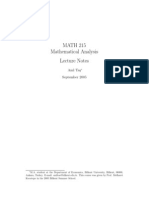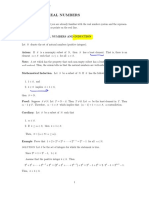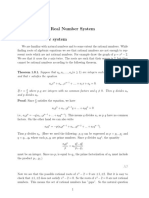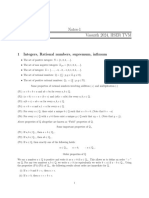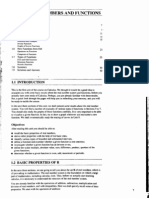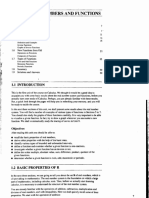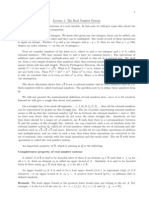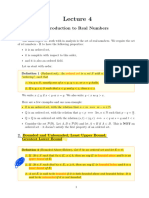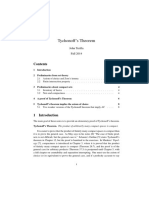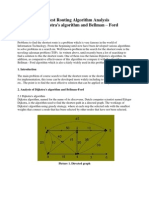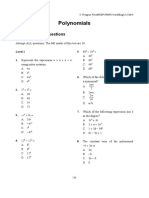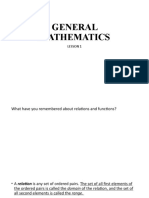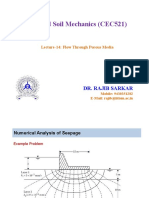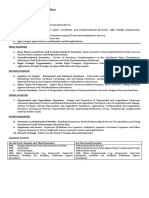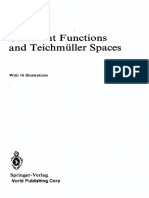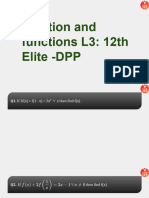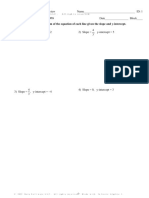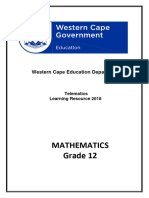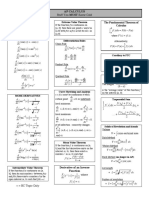Analysis I Spring 2025: 10 of 21
Lecture 2
Review
Definition (1.7). Suppose (S, <) is an ordered set, and E ✓ S.
(i) If there exists a 2 S such that x for every x 2 E, we say
that E is bounded above, and we call an upper bound of E.
(ii) If there exists a 2 S such that x for every x 2 E, we say
that E is bounded below, and we call an lower bound of E.
Definition (1.8, supremum). Suppose (S, <) is an ordered set, E ✓
S, and E is bounded above. Assume there exists an ↵ 2 S with the
following properties:
(i) ↵ is an upper bound of E.
(ii) If < ↵, then is not an upper bound of E.
Then ↵ is called the least upper bound of E (often called the supremum
of E), and we write
↵ = sup E.
10
�Analysis I Spring 2025: 11 of 21
Definition (1.10). An ordered set S is said to have the least-upper-bound
(l.u.b.) property if the following statement holds:
If E ✓ S, E is nonempty, and E is bounded above, then sup E exists in S.
Theorem (1.11). If an ordered set S has the least upper bound
property, then it also has the greatest lower bound property.
Proof? Be careful, we cannot use x, because S is only a set (not a field),
and thus we have not established that additive inverses exist in S.
11
�Analysis I Spring 2025: 12 of 21
1.2 Real number sysem R
Theorem (1.19). There exists an ordered field R that has the least-
upper-bound property. Moreover, R contains Q as a subfield.
• The second statement means that R is a larger set containing Q, where
addition and multiplication for elements of Q work exactly as in Q.
• Moreover, the positive rational numbers remain positive in R.
• The elements of R are called real numbers.
Construction of the real numbers from Q
• Step 0. Embedding Q into 2Q
We can regard each rational number q 2 Q as the subset
{ x 2 Q | x < q}
of Q. Note that q = sup{ x 2 Q | x < q}. More precisely, define a map
F :Q ! 2Q , q 7! { x 2 Q | x < q}.
This F is injective, so we may identify its image F (Q) ⇢ 2Q with Q
itself. There is an inverse map (the sup) that sends F (Q) back to Q.
The map F preserves the algebraic structure of Q over to F (Q). For
instance, we define
F (a) + F (b) := F (a + b),
and similarly for multiplication, etc. However, this map is not sujective,
because certain subsets of Q (for example, A = { x 2 Q : x2 2 }) do
not have a supremum in Q.
12
�Analysis I Spring 2025: 13 of 21
• Step 1. Define Cuts
A nonempty subset C ⇢ Q is called a cut if it satisfies:
(a) C 6= ? and C 6= Q.
(b) If c 2 C and x < c, then x 2 C.
(c) If c 2 C, then there exists some x > c such that x 2 C.
For example, for any rational q, the set { x 2 Q : x < q } is a cut.
However, there are cuts that do not correspond to any rational number.
One such example is
S = { a 2 Q : a < 0 or a2 2}.
It is straightforward to check S is a cut, but S 2
/ F (Q).
p
Question: Why not simply define S = {a 2 Q : a 2}?
• Step 2. Define R as the set of cuts in Q
We define R to be the set of all cuts in Q, i.e.
R := { C ⇢ Q | C is a cut}.
Then one can verify:
1. R is ordered by set inclusion (⇢).
2. We can define addition on cuts by
C1 + C2 := { x1 + x2 | x1 2 C1 , x2 2 C2 }.
3. Multiplication is more involved, but it can also be defined in a
consistent manner.
4. With these operations, (R, +, ·) becomes a field.
5. Moreover, (R, +, ·, ⇢) is an ordered field.
6. Finally, R satisfies the least-upper-bound (l.u.b.) property.
13
�Analysis I Spring 2025: 14 of 21
R is Archimedean
Theorem. 1.20(a). If x, y 2 R with x > 0, then there exists a positive
integer n such that nx > y.
Proof. Suppose, for contradiction, that no such n exists. Consider the set
A = { nx : n 2 Z+ }.
A is nonempty, and we assume it has y as an upper bound. Then A has a
least upper bound, call it ↵ y.
Then how do we derive a contradiction?
14
�Analysis I Spring 2025: 15 of 21
Q is dense in R
Theorem. 1.20(b). If x, y 2 R and x < y, then there exists some p 2 Q
such that
x < p < y.
Proof. Since x < y, we have y x > 0. By Theorem 1.20(a), there is an
integer n satisfying n(y x) > 1. Equivalently, y x > n1 .
Also by the Archimedean property, we can find integers m1 , m2 such that
m1 > nx and m2 > nx, i.e. m2 < nx < m1 .
Thus there is an integer m with
m2 m m1 and m 1 nx < m.
Then
nx < m nx + 1 < nx + n(y x) = ny.
Dividing the inequalities by n yields
m
x < < y,
n
and we set p = m
n 2 Q. This completes the proof.
15
�Analysis I Spring 2025: 16 of 21
nth roots of positive reals
Proposition. 1.18. The following statements hold in every ordered
field:
(a) If x > 0, then x < 0, and vice versa.
(b) If x > 0 and y < z, then xy < xz.
(c) If x < 0 and y < z, then xy > xz.
(d) If x 6= 0, then x2 > 0. In particular, 1 > 0.
(e) If 0 < x < y, then 0 < 1/y < 1/x.
- for the proof, refer to page 8.
Theorem (1.21.). For every real y > 0 and every integer n > 0, there
exists one and only one positive real y such that
xn = y.
p
This number x is written as n y or y 1/n .
Proof.
Uniqueness. First, we claim any such x is unique if it exists. Suppose
x1 , x2 2 R+ are both solutions to xn = y.
If x1 < x2 , then how do we derive a contradiction?
16
�Analysis I Spring 2025: 17 of 21
Existence. Next, we seek an x satisfying xn = y. Define the subset
S = { a 2 R+ | an < y}.
We have
y
• S 6= ?: Since a = 1+y satisfies 0 < a < 1 and, hence, an < a < y. Thus,
a 2 S.
• S is bounded above. Indeed, if a > 1 + y, then a 1 and an a > y.
This implies that 1 + y is an upper bound of S.
• Since S is nonempty and bounded above, sup S exists in R because R
has the least-upper-bound property.
Set
x := sup S.
Clearly, x 2 R+ . We claim xn = y.
If xn > y or xn < y, then how do we derive a contradiction?
17
�Analysis I Spring 2025: 18 of 21
Extended real number system
We can add ±1 to R, and call the union R[{±1} the extended real number
system. We define:
sup S = +1 if S has no upper bound in R;
and
inf S = 1 if S has no lower bound in R.
Although the extended real number system does not form a field, we have
the following conventions:
(a) If x is real, then
x x
x + (+1) = +1, x (+1) = 1, = = 0.
+1 1
(b) If x > 0, then
x · (+1) = +1, x · ( 1) = 1.
(c) If x < 0, then
x · (+1) = 1, x · ( 1) = +1.
18
�Analysis I Spring 2025: 19 of 21
Euclidean spaces
We consider the Cartesian product of R with R, i.e.,
R2 := R ⇥ R := {(x1 , x2 ) | x1 , x2 2 R}.
Over R2 , we define the following operations:
• Addition:
(x1 , x2 ) + (y1 , y2 ) = (x1 + y1 , x2 + y2 ).
• Scalar multiplication:
R ⇥ R2 ! R2 , c · (x1 , x2 ) = (c · x1 , c · x2 ).
These two operations make R2 into a 2-dimensional vector space (linear
space) over the real field R.
We define the Euclidean inner product by
2
X
h(x1 , x2 ), (y1 , y2 )i = x1 y1 + x2 y2 = xj yj
j=1
and the corresponding norm by
p q
|(x1 , x2 )| = h(x1 , x2 ), (x1 , x2 )i = x21 + x22 .
19
�Analysis I Spring 2025: 20 of 21
We generalize R2 to Rk :
x = (x1 , x2 , . . . , xk ) 2 Rk ,
k
X
x·y = xi yi ,
i=1
and !1/2
k
X
|x| = (x · x)1/2 = x2i .
i=1
Theorem 1.1. Suppose x, y, z 2 Rk and ↵ is a real number. Denote by | x |
the usual Euclidean norm of x. Then:
(a) |x| 0.
(b) |x| = 0 if and only if x = 0.
(c) |↵x| = |↵| |x|.
(d) | x · y | |x| |y|.
(e) |x + y| |x| + |y|.
(f) |x z| |x y| + |y z|.
20
